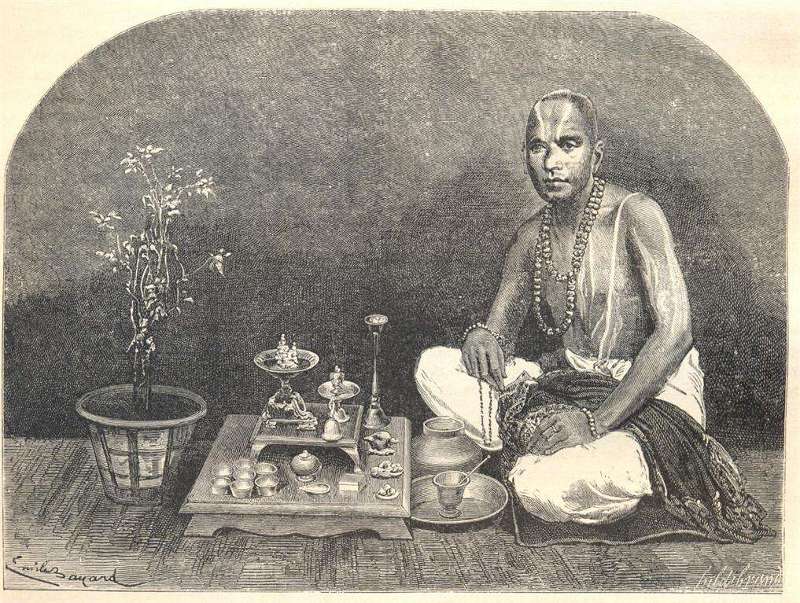FWP:
SETS
RELIGIONS: {60,2}
ROAD: {10,12}
ABOUT the zunnār , and STYLIZATION: In the ghazal world the word zunnār refers to a Brahminical sacred thread. But see the definition above, which makes clear that its earlier meaning was something quite different (a waist-cord or belt) from an entirely different cultural context (Eastern Christians, Jews, Magi). In {109,5x}, the zunnār is equated with (Islamic) religious smugness or pride. In {112,1}, it's unfortunately been torn away by the lover in his madness. By contrast, {117,4x} and {145,7x} feature the zunnār-e mīnā , a line that appears in a wine-flagon. In {143,7x} the zunnār becomes a street or lane, just as in the present verse.
The extreme stylization of the ghazal world makes this kind of semantic repurposing easy and convenient (and usually even invisible). Another such example: {39,5x} and {298x,4} with their nāqūs (repurposed from a Christian gong to a Hindu conch-shell). On the idea that 'Hindu' means 'black', see {138,6}. Then there's {118,1} with its kunisht , a word for a wide variety of non-Islamic holy places from which only context enables us to select a Hindu temple. Another very broad term is dair , as in {93,3x} and {115,2}; Mir's usage makes it clear that a Hindu temple is meant (as in M{7,15}). There are also cases of shifting reference with no religious implications, such as the identity of the Nightingale, with its varying ornithological possibilities; for discussion see {33,3}. And there's also the case of the lālah , a tulip that readily morphs in India into a red poppy (see {33,1}). And for the repurposing of the Persian ḳhāk-andāz into the Urdu 'dust-bin', see {68,5}. Finally, the ubiquitous season of 'springtime' presents special problems of its own; for discussion, see {49,4}. An example from Mir: M{1746,1}.
Other highly stylized concepts, which may have been unknown to the poets and their audiences except through earlier ghazal verses, include: the 'paper robes' in {1,1}; chirāġhāñ in {5,5}; the 'blood-price' in {21,9}; metal mirrors in {34,2}; the 'wine-duck' in {49,1}; gul khānā in {67,2}; gul-bāzī in {71,6}; the 'line of the glass' in {81,6x}. There's also the petrified image of the beloved, with her nonexistent mouth ({91,4}), her vanishingly small waist ({99,4}), her awesomely tall stature ({38,4}), and her all-enveloping black curls ({14,6}).
The present verse is indeed a 'rakish' one; as Bekhud Mohani points out; Nazm observes that such a stance is the fundamental attitude of the ghazal. The ghazal poet disdains the guardians of ostentatious religiosity (the Preacher, the Shaikh, sometimes the Brahmin), and their ostentatious religious paraphernalia (the prayer beads, the sacred thread) as well.
The true seeker of the divine Beloved is carried along on a tide of passion, committed to following his quest to the point of death-- and beyond. Minor external tokens like sacred threads or prayer beads are useless, ludicrous, even contemptible in their pretentiousness. Thus the injunction (addressed intimately to a tū who might be the speaker himself) to remove the 'bumpy' prayer-beads and replace them with the 'smooth' sacred thread. (Alternatively, the verbs in the first line may be read as kar constructions with the kar colloquially omitted; for more on this see {58,7}.)
After all, everybody knows that travelers prefer a level road to a rough one. And why shouldn't they? The traveler-- literally, 'road-goer' [rah-rau]-- is rightly interested in the road as a means, not an end. Traditional religions may offer different paths, but they're all branches of the same road. It's moving along on the road that is the traveler's one real obsession. What better vision of the mystic's path can there be?
I can't resist including this equally enjoyable treatment of the subject by Mir Dard, which construes the thread on which prayer beads are strung as the Brahminical sacred thread:
zāhidā shirk-e ḳhafī kī bhī ḳhabar
ṭuk lenā
sāth har dānah-e tasbīḥ ke zunnār bhī hai
[Oh Ascetic,
just also pay a bit of attention to 'hidden idolatry'!
with every bead of the prayer-beads there's a sacred thread too]

Nazm:
The relationship between the prayer-beads and sacred thread is that both are roads, but the difference is that the sacred thread is smooth and the prayer-beads are a road in which it's necessary to face bumps. Poets always give preference to idol-houses, Brahmins, and sacred thread over Sufi hospices [ḳhānaqāh] and Preachers and Shaikhs and holy men and prayer-beads. And the intention is a taunt-- that is, what does the knower of mystical knowledge need with prayer-beads and holy men? (59)
== Nazm page 59